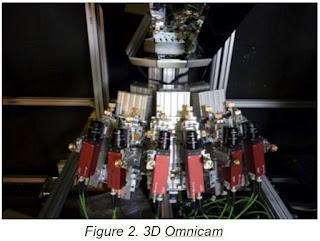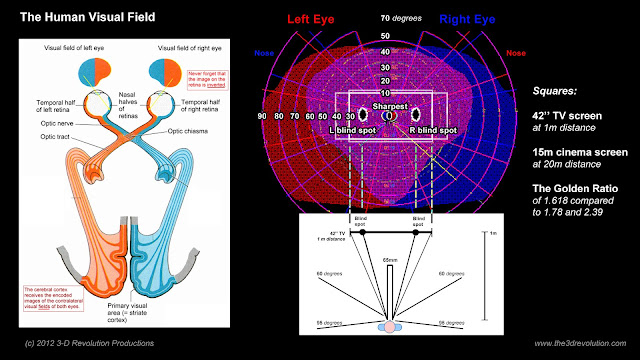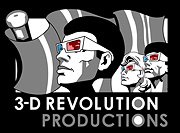5-Dimensional film making. What does it really mean?
5-D = 2-D + 3-D ?
 |
| 3-D movie poster for 'It Came From Outer Space' - conversion by 3-D Revolution Productions |
As technology reaches the limit of speed and human perception, we will move from a technology-based entertainment industry to an experience-based entertainment industry. At this point, entertainment progress will be measured in impact, no longer in the compliance to high spec technology. At the moment we are still in the technology upgrade era, but very soon, after the freeview 3-D 4K 144fps 14-stop screen projection / resolution and full surround 18.6 sound benchmark has been reached, entertainment will have to continue its development inward. Content will once again be developed over context.
There has
been a recent mentioning of the term ‘5-D’ by James Cameron as the future of
film production and sadly this is very much a current world model future, not a
true future world upgrade. So what does
Cameron mean by the term ‘5-D’? He is
referring to the production expense of shooting a film with a 3-D camera rig
and a regular single camera (2-D) at the same time. 2-D plus 3-D is in his books 5-D, hence the
term ‘5-D film’. This is the kind of
funny mathematics that marketing comes up with to coin a sales term, which 5-D
for three-camera filming is. Shooting a3-D film with a third camera for proper 2-D framing is something I have been
advocating for over a decade now, and it is good to see Cameron join me in the
opinion that one needs to employ dramatically different framing, compositing
and editing between a regular 2-D film and a 3-D film. The reality of tight production budgets is
that 100% of the film and television producers I have consulted on 3-D
production start laughing loudly when I suggest shooting or rendering
differently for the 2-D version of the film, but now that Cameron is backing me
up they will perhaps give the idea a second thought. More likely is the continued use of the left
eye version of the film for the 2-D release. But let’s get back to what true 5-D film
could mean.
 |
| James Cameron using grand gestures and big numbers. 1000% 12-D! |
3-D Film
Projected
film can at best show a 2-dimensional plane, like our eyes can at best see a
2-Dimensional plane at any given moment in time. Two cameras can, like two eyes, produce 2x
2-D and feed this to the brain to be experienced as a volumetric image. This is an experience of volume rather than
seeing in true 3-Dimensions because seeing in true 3-D would mean seeing all
sides of an object at any point in time.
A bit like the world in the Matrix, in short.
The key point to remember is the fact that our brain does the compositing in close to real-time, but only after the head and eyes have moved a little to generate a sequence of images that are combined into one – for true parallax estimation and thus depth calculation. Fix your head and eyes into one unmovable position and you won’t see ‘3-D’ depth and volume any more, despite having two eyes. The main reason for having two eyes is depth movement and speed estimation (how fast is the tiger running towards me) and contingency in case of the loss of one eye. This is why good 3-D layout and action is focused on staging in planes into the deep and movement in z-direction. Individually, each eye feeds information to the left and right side of the brain and as such is already a 3-D camera. In principle, each individual eye can create stereo information by means of rapid sampling and in-brain recompositing. Single point perspective works with one eye or two and is just that: one viewpoint and the resulting perspective from that one view. Infinite multi-point perspective would be true 3-D as well but the results on a 2-D plane are utter visual chaos. A fantastic subject for the next blog post...
 |
| Reverse and multi-point perspective as practiced in early Christian art. Were they on to something and did we turn things outside in? |
 |
| 'Woman with Blue Hat' by Pablo Picasso |
So true
3-Dimensional imagery could be possible, but before anything it would look like
a special visual effect or at least abstract art in motion. Yes, Picasso was indeed showing us true
glassless 3-D on a flat surface. The
argument of holography being true 3-D is only relevant so far as calling
statues or theatre true 3-D: the photonic information is there, it is still up
to our eyes and brains to observe the angles we can. As humans we can (currently) only see one
2-Dimensional slice at a time of the complete 3-Dimensionality and with our two
eyes this becomes a composite of two different angles – a composite in our
mind’s eye. We see a center image that
doesn’t actually exist (allelotropia) and if you are still not convinced of the
artificial nature of our vision, remember the two blind spots that are filled
up in real time by our brain by means of ‘error correction’. Also remember that no two persons see the
same amount of volume and depth because we all have different interocular
distances. A 6-year old child will see
the world flatter than an adult man, yet both will assert that when they touch
an object, it is with the volume and at the distance they see it with their
eyes. And that is colour acuity
aside. We experience a mental Matrix
then.
 |
| 4-D Cinema: moving chairs and water sprays |
4-D Film
The term 4-D film is normally used to describe 3-D or 2-D plus physical sensory input (a
moving chair, a water spray cued by moments in the on-screen film). Some theatres go as far as advertising ‘9-D
film’, which refers to the added sensory input of smell, taste, touch and ehm… no,
that doesn’t go up to 9 dimensions, unless the 6th sense is added to
the equation. Still, to call every sense
a dimension is somewhat confused but it makes for great advertising. Obviously, this is not 4-Dimensional in the
real scientific sense, but more a multi-sensory experience.
 |
| 4-Dimensional space as illustrated in 'Imagining the 10th Dimension' |
As the 4th dimension is assigned
to the passing of time, film itself could already be described as 4-Dimensional. As humans we experience time per moment, per
3-dimensional slice (yes, per 2x 2-Dimensional slice to be precise). Once can’t show the completeness of time in a
2-dimensional image other than by showing all frames of film at the same time –
which results in a complete mess. Donnie
Darko did a good job of approximating what that would look like for just one
person: a long blurry worm. Again,
showing true 4-D film on our current 2-D film will look like an odd visual
effect.
 |
| Donnie Darko's representation of time and spirit imprint / path |
Again we
can look at our experience of 4-D, time, and we come back to the image
composite in our brain. Because the
brain composits multiple saccades per 2-D slice and then multiple 2-D slides
per moment, combined into multiple stereo pairs for both eyes, every moment is
a composited representation of multiple milliseconds. Every moment, every composite, is done at a
minimum speed of 1/48th of a second since we do not experience
shutter in real life and in film we do not experience shutter at 24fps with a
double shutter either. I compare the eye
to film because I think in film – in 3-D film to be precise.
| Saccade sampling as visualized by eye tracking |
Much more pleasant is 72fps film, after which
speed the experience becomes less pleasurable.
It should be no surprise to find out that digital cinema runs its 24fps
3-D presentations with a triple shutter, showing one stereo pair as
left-right-left-right-left-right within the timeframe of 1/24th of a
second, so every frame at 1/144th of a second and every stereo pair at 1/72th
of a second. This would mean that our
natural stereo vision runs at around 72fps, while our visual resolve is clearly
still up to the task of perceiving 144fps.
But then that is 4-D and the experience of time are: a mental composite of
delayed sensory input experienced in sequence, creating a mental experience of
now, a few moments ago and the anticipation of a few moments from now in
one. To produce a true 4-D film we will
need to operate on a mental level and access our brains in a more expansive way
than just by presenting 2-D image slices in sequence. The 4th dimension needs to be
encoded into the image like a Dolby Pro Logic signal and the image needs to
awaken the internal understanding of time and activate the mental experience.
Speaking of
high frame rates, the hero of ultimate cinematic experience, Douglas Trumbull,
is back from his Showscan past to bring us its digital equivalent: 120fps
curved screen mega light film. The
curved screen focuses the light to increase it and retain polarization better,
whilst reducing hot spotting (the reason polarized 3-D projection is to be
outlawed in France, booh). Trumbull
suggests cranking up the light to 3x its current average brightness, but
theatre owners are turning down the lamps to save on their electricity bills
and lamp replacement costs. Only LED and
laser projection can help us there, then, although the issues of laser shimmering need to be addressed first.
Whilst Trumbull quotes 120fps as being an amazing framerate, he does
definitely also mention 72fps and 144fps as being at the peak of performance
for human eyes, but he is careful not to focus on those numbers because
standards left over from the analogue age still dictate 50 and 60fps in cameras
and projectors. 72fps is a framerate possible on the recently released version
2 software of D-cinema Christie projectors, but not a framerate supported by
the Digital Cinema Initiative workgroup, spearheaded by 50fps-fan Kommer Klein.
Klein does not know or does not want to
know about the natural, mental and spiritual benefits of 72fps and he only focuses on 50fps, 60fps and 120fps
in his advice. With these numbers, the
mass hypnosis of 60fps will continue.
 |
| Theta Brain Waves of 6-7Hz: Drowsly, sleepy state and readiness to process incoming signals |
 |
| Alpha Brain Waves of 8-12Hz: Relaxed mental state and wakefulness during sleep |
I
full heartedly agree with Trumbull that 72fps/144fps curved screen laser
projection will be an absolutely stunning cinema experience, impossible to
reproduce with TV screens and iPads (as is the case today, with underlit 2K
projection). A switch is flicked in our
brain and we perceive the images on screen as reality. This is a powerful potential that can be
called 5-D in the sense that the brain sees the projected imagery as an
alternative reality. Project a film with
subjects and visuals on a certain vibrational level and the brain will open up
its multi-dimensional portal – if this is something you wish to do as a film
maker.
5-D Film
And this
then brings us to the true meaning of 5-D and the potential use of the 5th
dimension in film.
There is a
great connection between the movies Avatar, the Lord of the Rings, Star Wars,
Harry Potter, Hero, Dune and 2001, the plays of Shakespeare and the music of
Adele, Pink Floyd and Mozart. They are
all incredible blockbusters shaping our very culture and they all employ heavy
use of Quantum Tunneling and access to the common human memory through the use
of connected, sacred symbolism and archetypal storytelling. They vibrate on the right frequency in
colour, shape, word, rhythm and sound. When a movie, play or piece of music
vibrates with our very being it opens up our higher self and we feel the
importance of the message. These
products can then be called to operate in 5-Dimensional space; they operate
outside of time and space and open up true inter-dimensional energy exchanges
to tap into pure potential. Potential
and all possible outcomes is the very definition of 5-D space and so film
operating with the right resonance on some or all levels can be called 5-D film.
| Sacred symbolism in Avatar |
Avatar is a
great example of what a movie operating on a higher level can do. The biggest
money making film of all time is a story about native people protecting their
sacred tree from corporate greed and militarism. You were saying the subject of connecting and
communicating with nature and higher spheres of consciousness is not an
interesting sell? It is either THE sell
or there is a bigger truth to the importance of congruence. With Avatar, the message equals the form –
the content equals the context. Having
the context operate on a deep psychological level means half the battle for the
heart (and the boxoffice Dollar) of the audience is won. Once both the psychology of the story AND the
symbols used in cinematography, 3-D scene layout, colour use, editing rhythm,
sound design and the marketing campaign are performed on a deep level, the
audience will be cramming to come back to the theatre again and again.
| The Na'vi plug into the Tree of Souls |
 |
| Shiva - inspiration for the Na'vi |
James
Cameron tells us the idea for the film Avatar came from a dream his mother had,
which says it all really. It is an internal image, be they dreamed up during
REM sleep or in a lucid dream, a vision of meditation, and the art of Avatar
certainly connects closely to ‘spiritual’ art and visual representations of
visions encountered during natural or chemical activation of the pineal gland. Why did a global movie-going audience go and
see Avatar two, three times in a row and describe its experience as deeply
emotional, spiritual? Because the whole
of that movie taps into a deeper truth inside ourselves, outside of cultural
and religious peculiarities – it goes to a deeper level of existence, of
sub-atomic particle vibration.
One film
maker who works in this realm in a very overt way is David Lynch. His films can most definitely be called 5-D
because they feature characters that are in multiple places and timeframes at
once, feature forward and reverse time, they feature multiple possible outcomes
of the same story, parallel lives and entities from different dimensions
altogether. It is not strange to learn
that Lynch comes to these images and stories through the means of
transcendental meditation – the imagery comes straight from the realm of the visual
cortex and the pineal gland and knows no bounds in either direction of space,
time and possible outcomes. The images
are powerful, if confusing and unnerving – we know the universe is coming apart
at its seams when watching these visions, but are we experiencing the same kind
of harmony and revelation as we do after 3 hours of Avatar? The execution of the same principles is
completely different. For his imagery, Lynch
goes to a dark place inside his mind and possibly even a daemonic level on a
spiritual plane, whereas Cameron takes his images from dreams and Native Indian
stories. Still, one can refer to the Edgar Tolle quote stating: "The moment you become aware of a negative state within yourself, it does not mean you have failed. It means that you have succeeded.". As Lynch himself puts it: "If you have a golfball-size consciousness, when you read a book, you'll have a golfball-size understanding. When you look out, a golfball-size awareness.". Time to expand the consciousness to have a football-size awareness, but be careful of where you allow that awareness to take you. Darkness is as equally present as the Light and it certainly makes for amazingly scary movies.
 |
| The deamon guide living in reverse time - an anti-matter spirit |
Lynch also
shows us what a society would look like after a 5-Dimensional revolution in
'Dune' – a film based on the book of course, but visualized in way that skates on the boundary of reality. In the
Universe of 'Dune' space travel is possible and effortless through the use of the
Spice and its space-folding properties.
The Spice mélange also gives visions of the future and an insight into
the truth. It is clear that the Spice is
a DMT-style drug and that the travelling without moving is astral
projection. The proposal is, then, that
in the future we will have managed to not only Astrally project ourselves to
wherever we want in space, we can also physically materialize at that
location. The dreamer must awaken: once
the Pineal Gland is accessed unobstructed, our eyes will open to the truth of
the Universe. In 'Dune', this clarity does
not stop intergalactic wars, but it does give the enlightened ones the tactical
advantage and eventual victory.
 |
| The Spice Melange at work |
The
later Lynch films ‘Lost Highway’ and ‘Mulholland Drive’ go even further in
their 5-D expression and split up into alternate realities for the protagonist
of the films. Multiple possibilities are
taken literally here, and the holographic nature of the universe is re-iterated
halfway through the film: “Silencio, it is all a recording” an extra-reality performer states. We move with our consciousness through the
Mandlebulb of potential reality and perceive one slice of reality at a time
depending on the direction we have chosen to take. Very much like the technology of holography
and holographic computer storage: the three-dimensional point chosen to observe
reveals one image or one bit of information of the complete, the source field. Whether we observe a recording, create a
reality or compose a reality from a field of infinite possibilities is the
bigger question, but somewhat of an irrelevant one if the controlling factors
and the end results are the same.
 |
| The Cauliflower of space-time-potential reality. Delicious with a sauce of Intention, divine with a glass of reflection.. |
The sleeper must awaken
Film itself
is, of course, already a presentation of a condensed reality and a unique
medium that can show us the subjective reality of its characters in specific
and subjects at large. Through film we
can travel without moving. Film fulfills
its potential best when the reality of inner life, vision, potential and change
are played out, but also the seemingly impossible, the transcending, the
movement between the sheaths of parallel universes. The viewer gets a God-like view and access to
the characters and their actions and 'Dune' takes this principle further to let
us hear the inner thoughts of all characters, whilst ‘Lost Highway’,
‘Mulholland Drive’ and ‘Twin Peaks’
introduce reality-controllers who operate outside of space and time,
guiding and twisting fates of characters and resetting reality at times. These controllers have a view of the reality
they twist and contort, but it is not necessarily the only truth.
Physical reality as a spiritual prison and
spiritual form as a moment away from physical pleasure – a lower spiritual look
upon life, but a very interesting one to ponder upon. What medium better than film to visualize
this higher reality? Complete experience
can be ours as an audience through film and although figuring out Whodunnit is
fun, it doesn’t get better than to see what cannot be in real life, unless one
has a consciousness that is completely open wide.
The
reference of 'Dune' to the dreamer or sleeper needing to awaken is a direct link to
the teachings of Hermes Trismegistus and derivatively the words of Gurdjieff and his Fourth
Way. ‘Wake up mankind, you are asleep
and not accessing your true, full potential’.
Even the driest scientist and agnostic analyst will agree with this
statement, and when I say agnostic it has to be said that Hermetic teaching is
Gnostic and not a religious view but a Quantum Mechanical view of the Universe – as
explained in the time of ancient Egypt.
The truth is there to see for he who looks, but to fully awaken, one
must keep working on keeping the paths open and clear of obstruction.
 |
| 'Hero' by Yimou Zhang. The good of the many... |
A more
recent example of 5-Dimensional film techniques can be found in 'Hero' by Yimou
Zhang. This movie manages to tell the
story of finding the truth through meditation upon sword fighting, calligraphy
and the vibration of the blade and pen as they scrape their counter parts rival
blade and paper. The use of colour is
not just incredibly beautiful – it is beautiful for the reason of communication
with Chakra points and the path from root Chakra to Crown, from the green of
nature to the violet and white of the universal truth. The first emperor of the Six Kingdoms brings
unity and peace to the land now called China, but has to use force to do
so. A film about conquest and personal
vendetta can operate on the highest level of hyper-dimensional visual
storytelling and the opening of eyes to the truth. It doesn’t just have to be documentaries on
Yogis, Fakirs and Quantum Physisists telling you about your inborn metaphysical
potential (e.g.: 'What the Bleep do we know?', 'What about Me?').
 | ||
| Being half Vulcan and half Human,Spock may well embody teacher of logic and matters of the mind to mankind, Thoth Mercurius |
I strongly suspect a similar link as found in 'Dune' between Astral projection and space
travel in the 'Star Trek' series. The engines of the Enterprise literally
run on ‘dilithium crystals’: a reference to the 5-dimensional properties of
crystals and the Pineal Gland activation of drugs. There are plenty of references to mysticism
and occultism in Star Trek – think of the Vulcan greeting, a Cabalistic
mystical greeting and the fact that Vulcans come from a planet very similar to Mercury, while they
teach Man about matters of the mind like telepathy, mind-melds, pure logic
and the secrets of space travel. These are all references to Hermes Mercurius Trismegistus, the
first teacher of mankind. Then there are of course elements such as the
Obsidian order, a reference to the obsidian scrying mirror and the great
Barrier being the edge of the Cosmic Egg.
Star Wars, then, also uses plenty of references to Egyptian Occultism such as Djedi,
the Magi who controlled mind and matter, the followers of Seth, god of darkness,
and of course the Skywalkers travelling to and from distant planets through
Hyperspace. But nothing as overt and
open as what is seen in 'Dune'.
 |
| Djedi raise the Djedd. Eternal life and a Lightsaber, anyone? |
The axiom of "The lips of wisdom are closed, except to the ears of understanding" will become: "The eye of wisdom is open to the viewer of 5-D film". Soon, the
power of hyper-dimensional movie making will be available to your film
production through a new venture set up by 3-D Revolution Productions. Your audience will no longer fall asleep in
the cinema, it will actually completely awaken.
And the audience will certainly awaken to a desire for more of the same
experience, more vision and more clarity.
Contact 5DLux for more information on 5-D filmconsultation and the potential to collaborate in this new field of film making.










